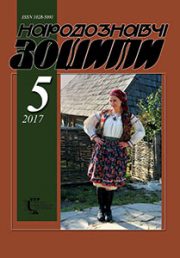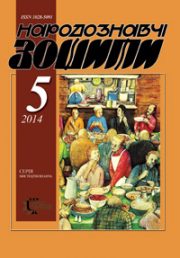The Ethnology Notebooks. 2020. № 1 (151), 27—35
UDK[39:81’28:[7.04:27-526.62](477.46-21)”18/19″(092)
DOI https://doi.org/10.15407/nz2020.01.027
TRISKA Oksana
ORCID ID: https://orcid.org/0000-0002-4717-4396
Сandidate of Arts (Ph. D), Senior Researcher
Institute of Ethnology of the National Academy
of Sciences of Ukraine, in the Department of Folk Art,
15, Svobody Avenue, 79000, Lviv, Ukraine,
Contacts: e-mail: oksana_triska@yahoo.de
Abstract. The article analyzes the folk rituals of Zvenygorod region in terms of religious traditions rooted in everyday life. The Actuality of the work consists in introduction to the scientific circulation of the work of A. Krymsky «Zvenygorodschyna. Shevchenko’s homeland from the ethnographic and dialectological point of view». The subject of the research is the folk calendar, legends and Christian beliefs recorded in the villages of Zvenygorod region. The ceremonial traditions associated with the theology and use of domestic icons act are the main object. The purpose of the article is the comparison of folk beliefs with the theme of icons distributed in rural areas of the last quarter of the 19th — beginning of the 20th centuries, and the comparison of oral and visual information. The structural method is applied, as the main one in the complex analysis of religious ritualism, as well as the comparative one, which allows to draw parallels between folk, religious and iconographic traditions of the described region.
The study revealed that the ritualism of the rural population of Zvenyhorodschyna was based on archaic worldview, which relied on the gravity of folk traditions. The main information about domestic icons can be found in the folk calendar. Christian beliefs shaped the way of life and accompanied the peasant from his birth to death. Time was counted from holiday to holiday — it was closely intertwined with agricultural rites and folk signs. One of the most important parts was the utilitarian combination of ritualism and life realities. The villagers put their hope in the care of the saints in all their life cycles. First of all, the «chief gods» are Jesus and the Virgin Mary. Prayer to St. Nicholas helped with various needs. St. Julian and St. Kozma and Demian were the guardians of the children. The only image that had a clear household, not just a spiritual use was the icon of the Virgin Mary Burning bush — according to eyewitnesses, she stopped the fire. Comparison of Christian beliefs with iconography of domestic icons does not make it possible to speak of their full conformity. Icons created a common cult of piety in homes, only partially illustrating local religious traditions.
Keywords: ethnographic records, domestic icon, folk rituals, legend, household custom, iconography.
Received 3.01.2020
REFERENCES
Lykhach, L., & Kornienko, M. (2000). Icons of Shevchenko region. Kyiv: Rodovid [in Ukrainian].
Zadorozhny, V.B. Pogodin-Sobolevsky theory. Isbornik. Retrieved from: litopys.org.ua [in Ukrainian].
Krymsky, A.Yu. (2009). Zvenyhorodschyna. Shevchenko’s homeland from the point of view of ethnographic and dialectological: Reproduction from the author’s model 1930. Cherkasy: Vertical [in Ukrainian].
Romaniv-Triska, O., Kis, A., & Molodyi, O. (2015). Folk icon of Chernihiv region: album. Lviv: Collectors’ Institute at the NTSh [in Ukrainian].
Nayden, O. (2009). Folk icon of Middle Dnipro region in the context of rural cultural space. Kyiv [in Ukrainian].
Chubynsky, P. (1872). Proceedings of the ethnographic and statistical expeditions of the South-West region (Vol. 2). St. Petersburg [in Russian].






